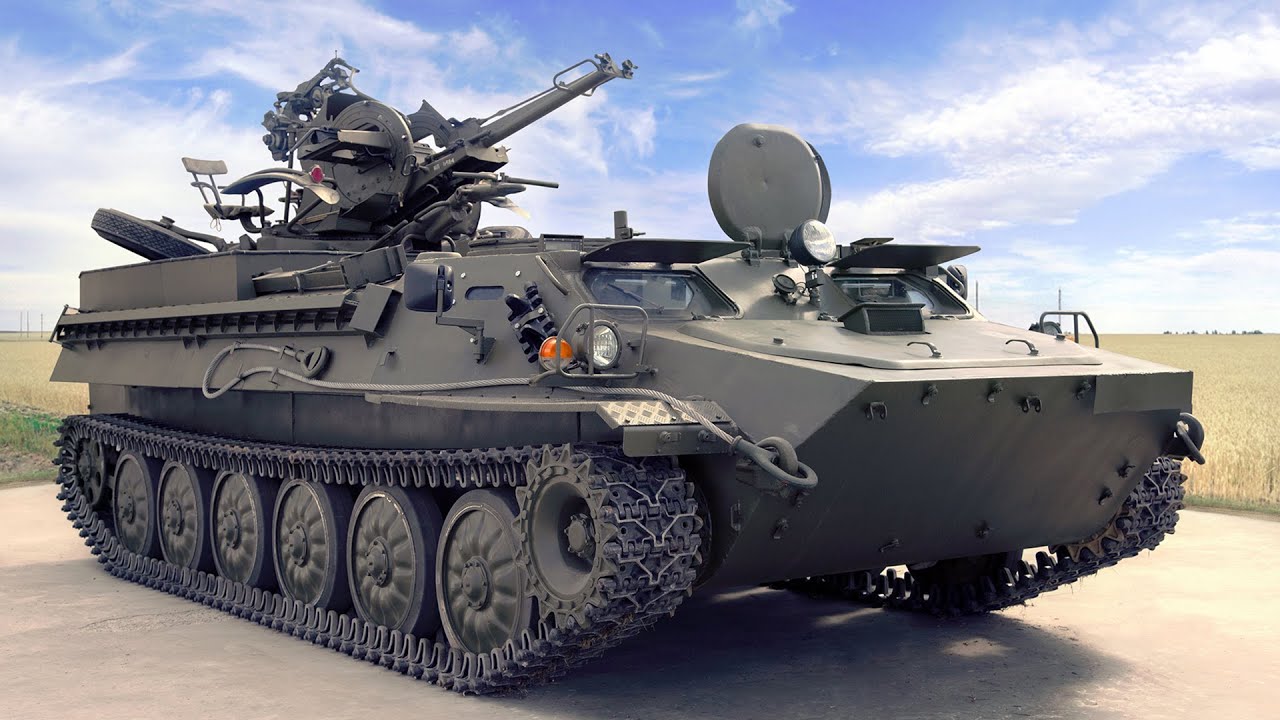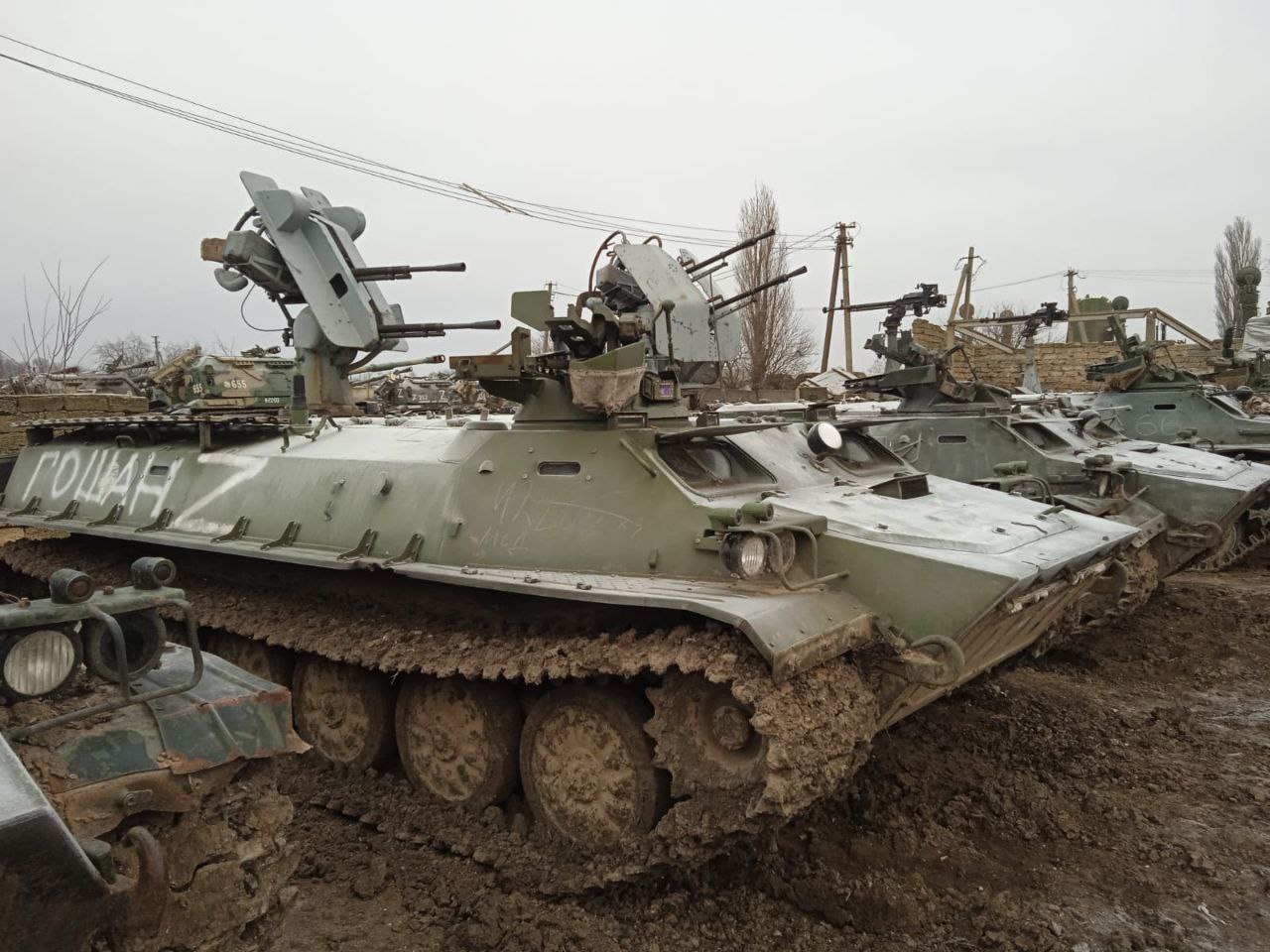MT-LB, also known as “Motoliga,” having passed through years and numerous wars, became a workhorse of the military of many countries, and an indispensable attribute of many military conflicts in the post-Soviet space.
Designed as a versatile tracked armored vehicle in the amount of more than 50 thousand units produced, it has become perhaps the most popular platform for installing various kinds of weapons and systems. This is what we will discuss in this article.
What is MT-LB?
The MT-LB is a multi-purpose light tracked armored tractor developed and adopted by the Soviet army in 1964. The vehicle was produced at the Kharkiv Tractor Plant and other Soviet enterprises throughout the Union. The former USSR and Eastern bloc countries, including Russia and Ukraine, remain its active users to this day.
MT-LB is designed to transport troops and cargo on roads and rough terrain. It can act as an artillery tractor for towed guns and carry ammunition for them.
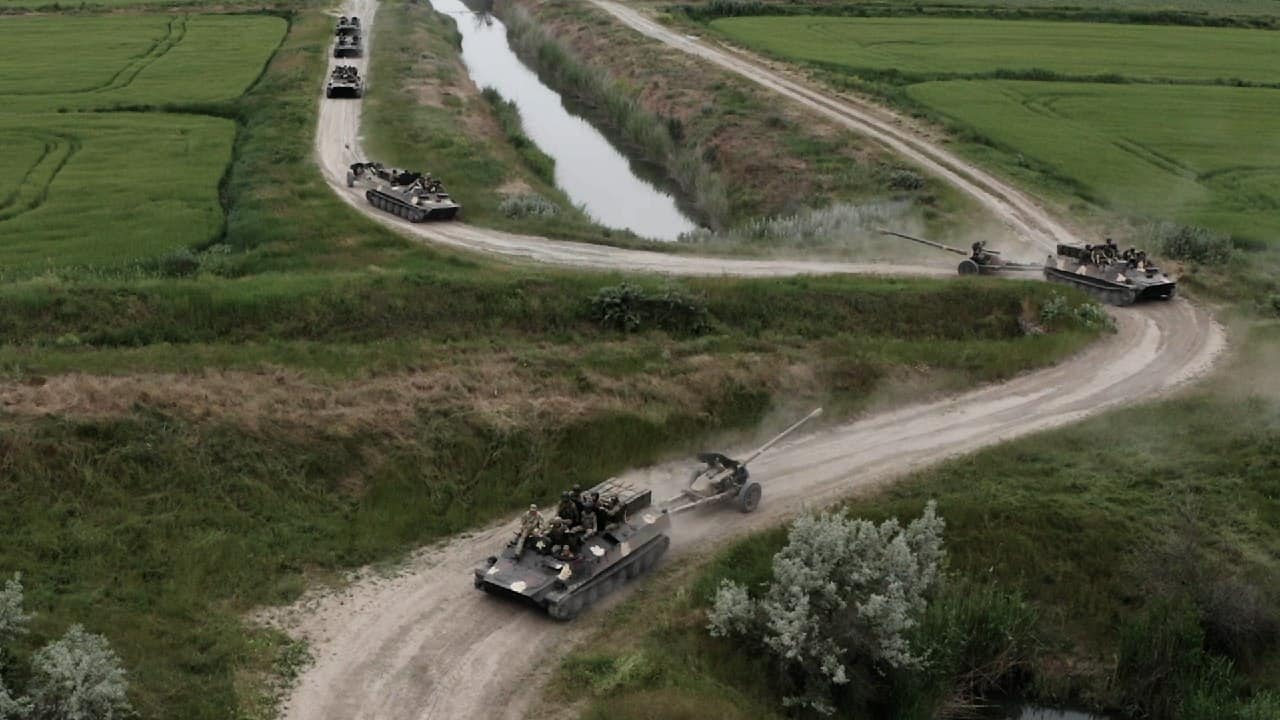
The vehicle designed for the Soviet army received a hull of armored steel. The thickness of the armored side panels and the vehicle’s stern is 7 mm at a slight angle, and the front part is between 7 and 14 mm thick. This is enough to protect against small debris and light rifle fire. However, 7.62mm assault rifles and machine guns can already penetrate this armor.
The tractor’s design assumes the use of a closed turret with a PKT machine gun for self-defense. Based on the design objectives, the vehicle was not supposed to engage in battle, so this should have been enough for it.
Fire Support Vehicle
The idea of converting tracked vehicles into improvised combat vehicles probably originated during their first “baptism of fire” due to high passability and armor, which could protect against light small arms.
The Russian-Ukrainian war was also no exception. In the face of a strong shortage of armored vehicles, both militaries are massively converting these vehicles and equipping them with various types of available rifle and artillery weapons.
Armored personnel carrier with DShK turret
One of the results of soldier improvisation was the use of tracked vehicles as nominal armored personnel carriers or infantry fighting vehicles.
The military installed heavy machine guns and automatic grenade launchers to increase firepower. The turret with the 7.62 mm PKT machine gun was also often dismantled and replaced with an open turret with weapons.
Thus, for example, the Russians, attempting to increase their survival chances, equipped their improvised APC with protection in the form of sandboxes welded to armor and tracked vehicles. A turret with a pair of 12.7 mm DShKM machine guns was added to the turret as a weapon.
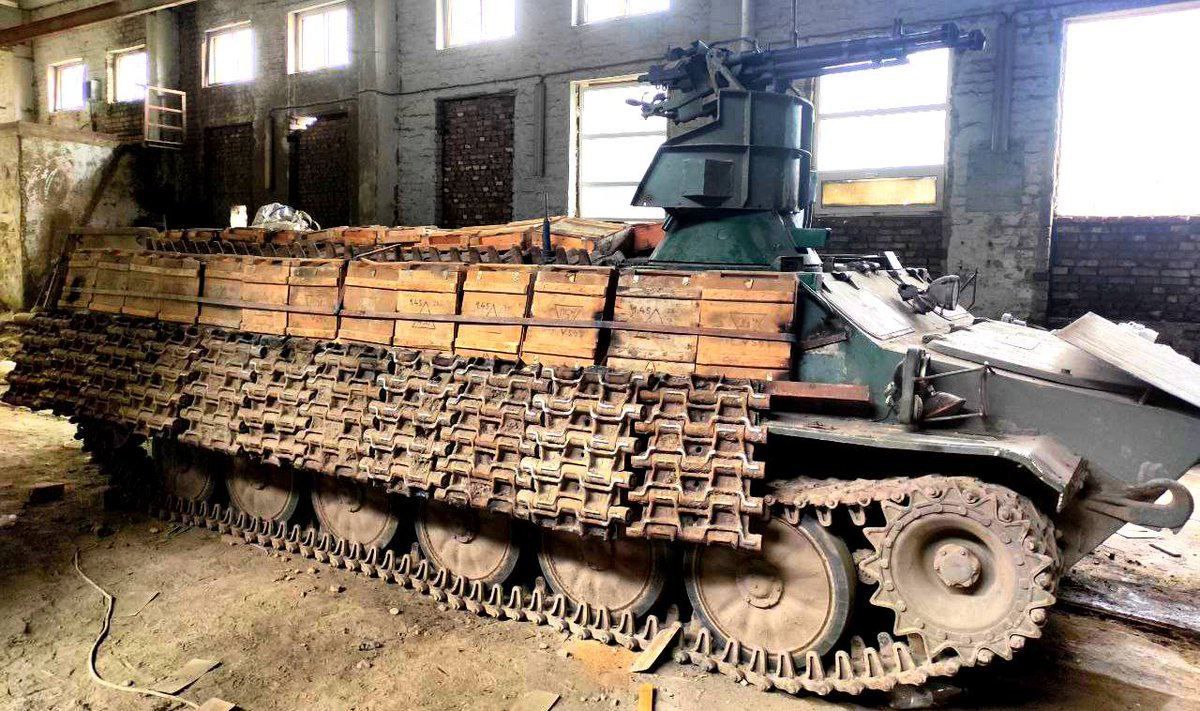
At the same time, even in the turbulent times of the “undeclared” war that began in 2014, the Ukrainian military faced the challenge of a shortage of operational armored vehicles and the need to supply the deployed troops with something better than the well-known yellow school buses.
To solve this problem, the conversion of tractors into armored personnel carriers was put on a production line. The technical task to dismantle the machine gun turret and re-equip the MT-LB with rotary platforms with the armor protection for the machine gunners and the DShKM machine gun was developed by the Central Scientific Research Institute of Armament and Military Equipment of the Armed Forces of Ukraine.
At the same time, by the end of December 2014, the Kharkiv Automobile Plant State Enterprise had already manufactured 62 rotary platforms with a DShKM 12.7mm machine gun. In early January, they were transferred to the 14th Mechanized Brigade.
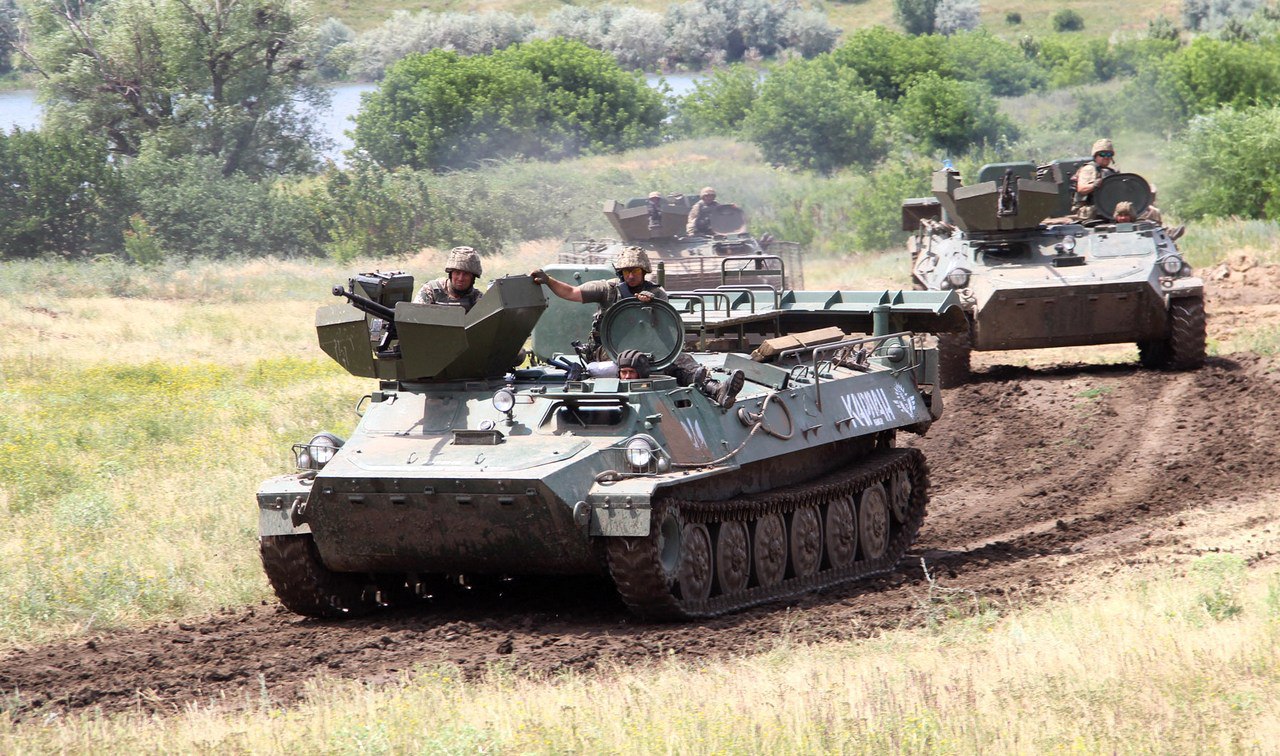
Subsequently, the 14th Mechanized Brigade was rearmed with BMP-1 infantry fighting vehicles, and MT-LB tractors with machine gun platforms were transferred to the Central Automobile Storage and Repair Base in the Khmelnytskyi region. However, with the beginning of the Russian invasion of Ukraine, these vehicles were returned to service.
Tractor as ZU-23-2 gun carrier
The installation of the ZU-23-2 automatic anti-aircraft gun on the MT-LB has become a legendary gold standard in the military history of recent decades.
A machine gun is not a very effective weapon for working through enemy combat formations, especially in shelters, and its range and destructive potential leave much to be desired, even when it comes to large-caliber systems.
At the same time, the ZU-23-2, commonly used in the military, is capable of effective fire at a distance of several kilometers, and its 23-mm ammunition can destroy fortifications, buildings, and even light armored vehicles. The installation of the system on a tractor did not deprive it of the ability to effectively fire on air targets.
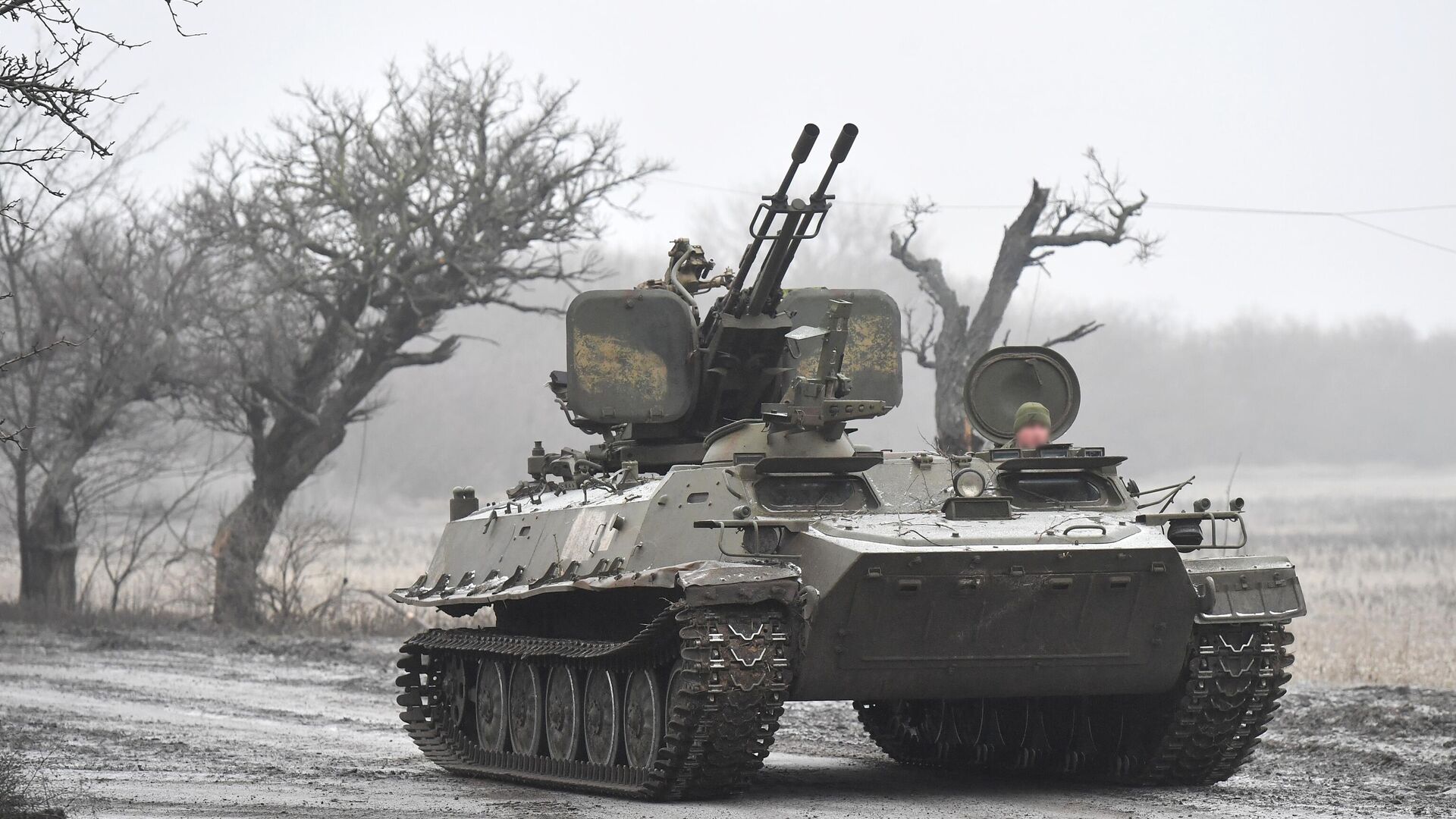
Due to the wide flat platform aft, the tractor is an excellent tool to transport goods and install various equipment, including anti-aircraft guns.
Self-propelled 82mm mortar
The installation of a 2B9 Vasylek 82mm automatic gun mortar on the mobile chassis is another rather massive phenomenon on both sides of the battlefield. The MT-LB did not escape this fate.
The mortar’s mobile fire teams are capable of striking the enemy near the frontline and avoiding counter-battery fire due to constant position change. The tractor, in this concept, acts both as a platform for a mortar and as an ammunition carrier in the squad compartment. The high passability of the tracked chassis allows the crew to work under any conditions without being tied to the roads.
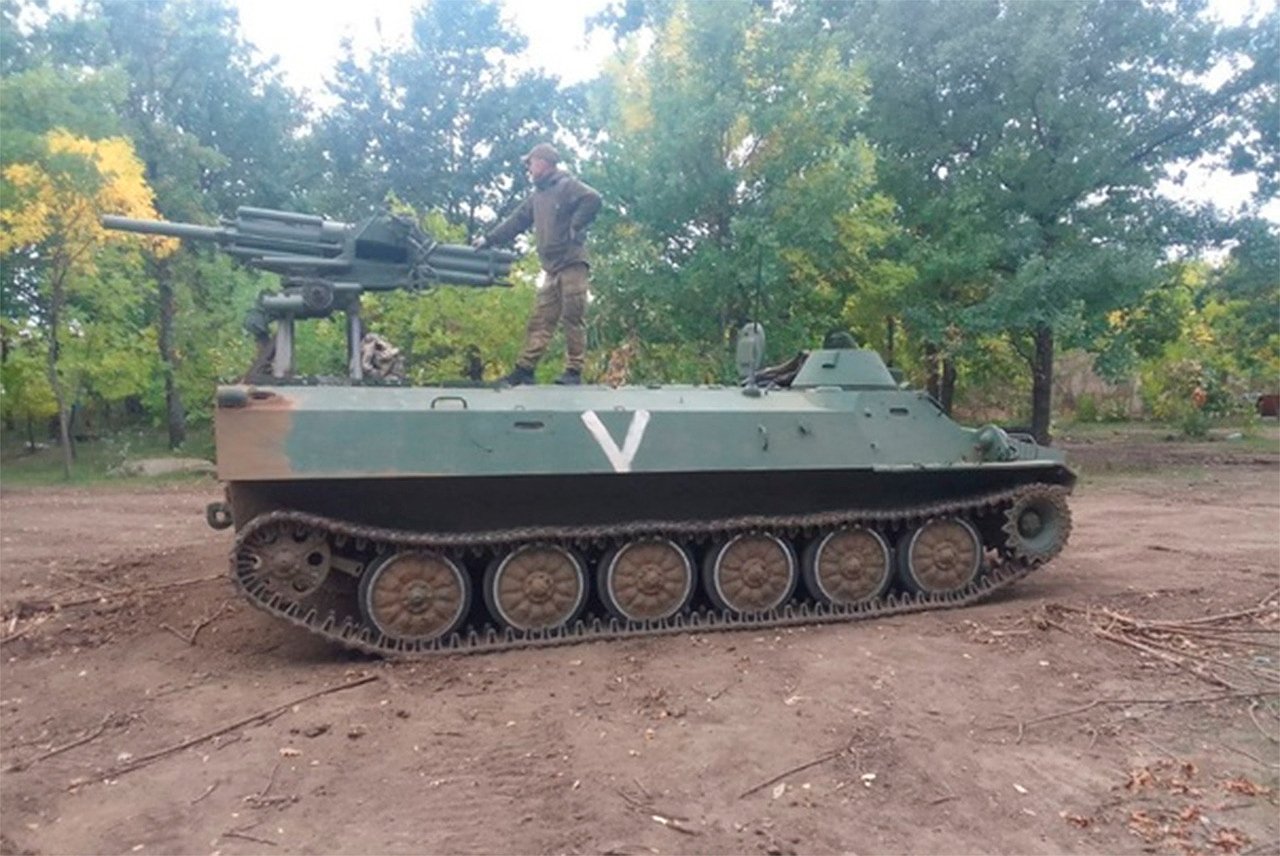
Self-propelled gun mount with S-60 gun
In October last year, due to a shortage of traditional fire support, decommissioned Soviet AZP-57 57mm guns of the S-60 anti-aircraft system started to appear on the battlefield.
Having a large caliber for an automatic gun, AZP-57 is able to successfully fight light armored vehicles that are massively used during the Russian-Ukrainian war. Due to the good combination of penetration ability and high-explosive action of projectiles, the system is also able to effectively knock out infantry from urban buildings and fortifications, using direct fire against them.
Another method of hitting enemy targets could be firing from closed positions. This is firing in a steep parabola using indirect guidance at a target that is out of the line of sight from an indirect fire position. This method reliably covers the vehicle from the enemy’s direct ground surveillance and therefore protects against response fire.
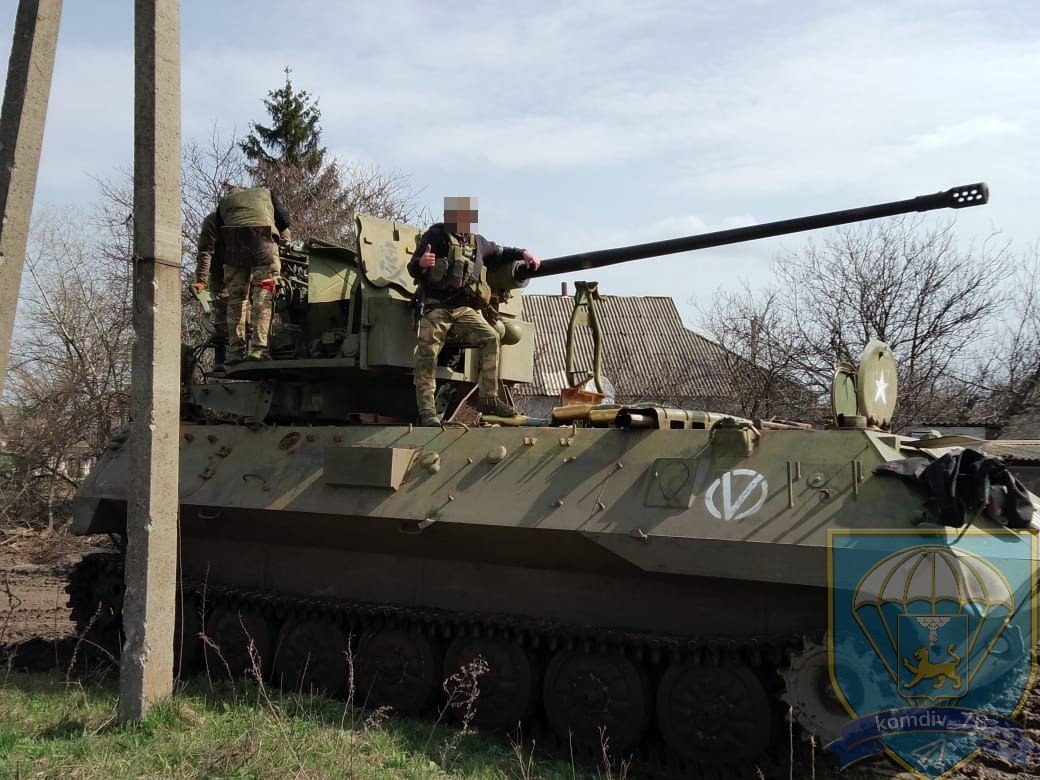
The use of 57mm guns from an indirect fire position, together with ballistic computers and reconnaissance UAVs, allows extending the effective firing range by a distance of over 6 km.
More on the use and features of the S-60 is available in the article “S-60 anti-aircraft gun in the Russian-Ukrainian war.”
Ukrainian ersatz self-propelled guns
The search for alternatives in the conditions of artillery shortage in the Ukrainian military led to the idea of mounting guns on the MT-LB tracked tractor chassis. Their installation on the mobile chassis allowed to actively move near the front line and fire from indirect-fire positions.
Self-propelled gun with МТ-12
One of the primary systems for such a conversion was the Soviet МТ-12 Rapira 100mm anti-tank gun.
In general, Rapira is a towed gun transported on a trailer by wheeled trucks or tracked vehicles. Its installment on the MT-LB chassis reduced the deployment time in the firing position and significantly increased the mobility, which was a weakness of this type of weapon.
In the course of crossing these two types of equipment, a part of the top of the squad compartment of the MT-LB was cut out, and additional structures were welded so that the energy of the shot would not immediately destroy the system. Ground chocks were installed on the vehicle to ensure stability and maneuverability in the combat position.
The vehicle’s full crew consists of 6 people, including a driver, a gunner, a commander, and three persons to load the shells.
Self-propelled guns with D-44 85mm gun
The Ukrainian military, mainly territorial defense forces, repeatedly used reactivated Soviet D-44 guns to work with HE-frag ammunition against enemy infantry.
This 85mm gun was developed back in 1944 as a field divisional gun. It can use both armor-piercing and high-explosive ammunition. Its maximum firing range from the indirect-fire position is 15,000 meters.
At least one DIY artillery mount based on this old Soviet gun was spotted during the war.
Little is known about this ACS. However, judging by the video, we can assume that many significant changes were made to install the gun on the tractor, such as cutting the top and welding the footings. The vehicle also received onboard slat armor.
Russian Navy’s modernization of MT-LB
In January 2023, a landmark event happened for the Russian army – the Russian Navy opened weapons depots and took out rare “designs” from storage to be installed on military equipment. This decision was presumably made in attempts to somehow strengthen the firepower of Russian units and compensate for the high losses of regular armored vehicles.
Self-propelled artillery system with М2-3M
One of the most bizarre results of this event was the emergence of a fire support vehicle with an ancient Soviet 2M-3M naval gun mount with two twin 25-mm M-110 automatic cannons.
According to some data, at least some of the vehicles modernized in this way were produced on the Russian facilities in the Primorsky Krai. This can confirm that the weapons were withdrawn from the reserves of the Pacific Fleet of the Russian Federation.
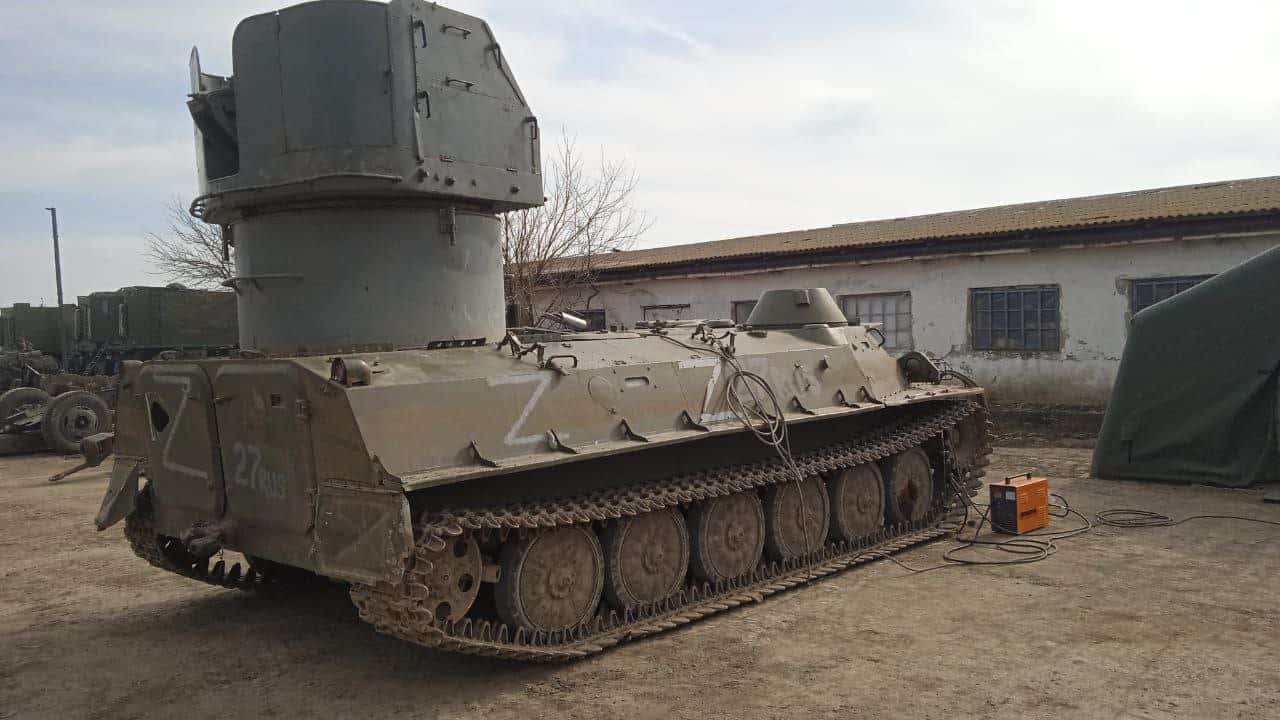
Self-propelled machine gun turrets
The Russians also resorted to installing old naval 2М-1 turrets with a 12.7mm DShKM machine gun and 2М-7 turrets with a 14.5mm KPV-14.5 heavy machine gun on the MT-LB chassis.
The new purpose of these vehicles is not clear. The most likely use is to support infantry, as their use as an air defense weapon is seen as ineffective.
It is also interesting to note that some of the pedestals are equipped with a postwar DShK mod. 1938 machine guns, manufactured in the Soviet Union during World War II and almost immediately replaced by a modernized version, the DShKM, which was devoid of most of the drawbacks.
- Russian MT-LBs with 2M-1 and 2M-7 naval machine gun turrets, January 2023. Photo from open sources
- Russian MT-LBs with 2M-1 and 2M-7 naval machine gun turrets, January 2023. Photo from open sources
Naval MLRS on MT-LB chassis
This is probably the only potentially effective type of weapon in the list of “naval” modernizations of the tractor.
In June this year, a photo first surfaced with the actual confirmation of MS-227 launchers of the А-22 Ogon 140mm naval multiple rocket launchers installed on the MT-LB chassis.
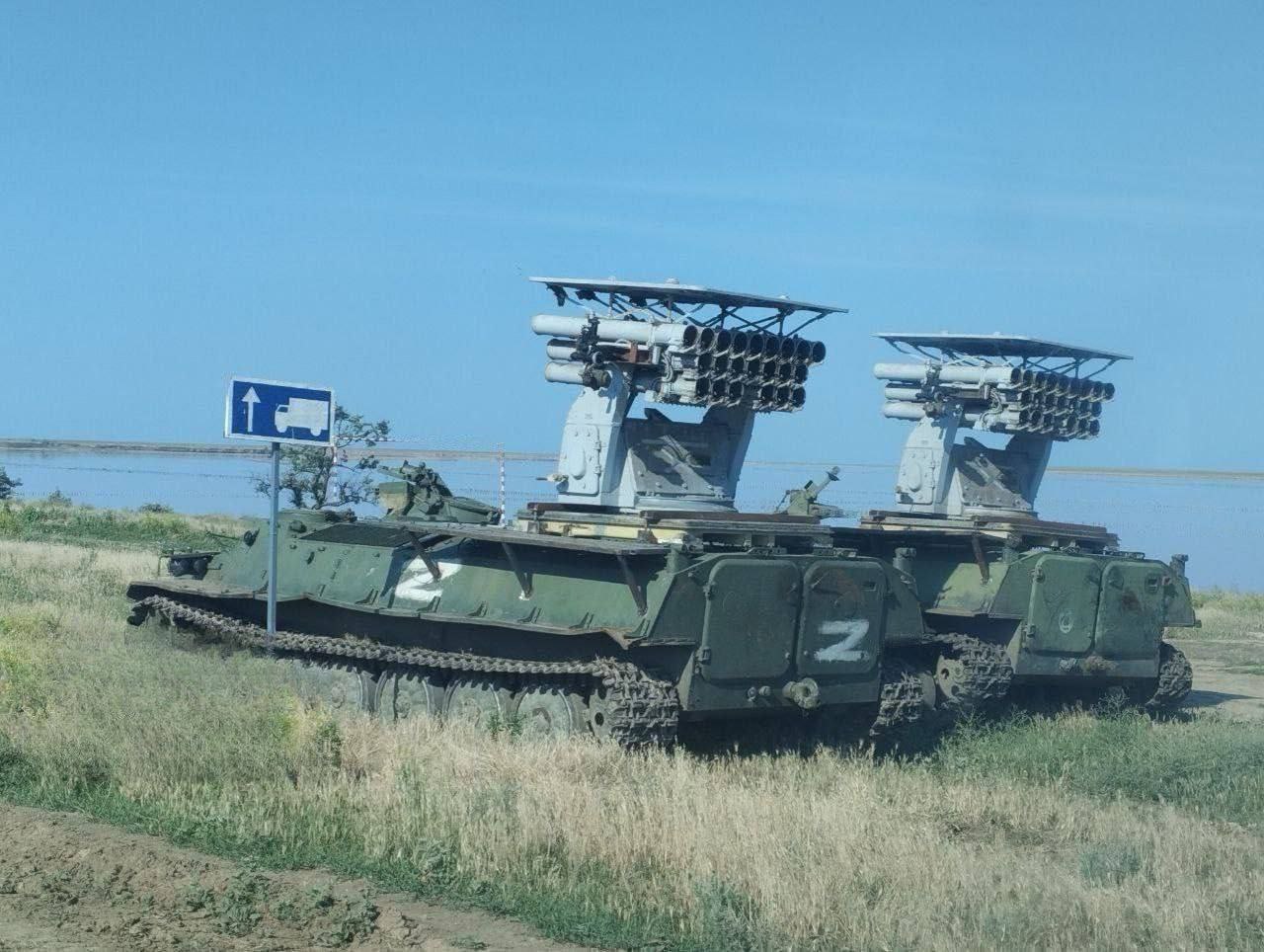
The Fire А-22 system is designed to arm landing forces. Its task is to defeat coastal targets located in a large area, enemy equipment, manpower in the landing zone, and enemy surface targets and create fires on enemy territory.
The МS-227 launcher with 22 rails can fire at a distance of up to 4500 meters using Soviet ammunition and up to 9500 meters using promising Russian ones (their availability in Russia is doubtful).
The А-22 Ogon MRL can use Soviet OF-45 fragmentation and ZZh-45 incendiary shells with a 4.5 km range.
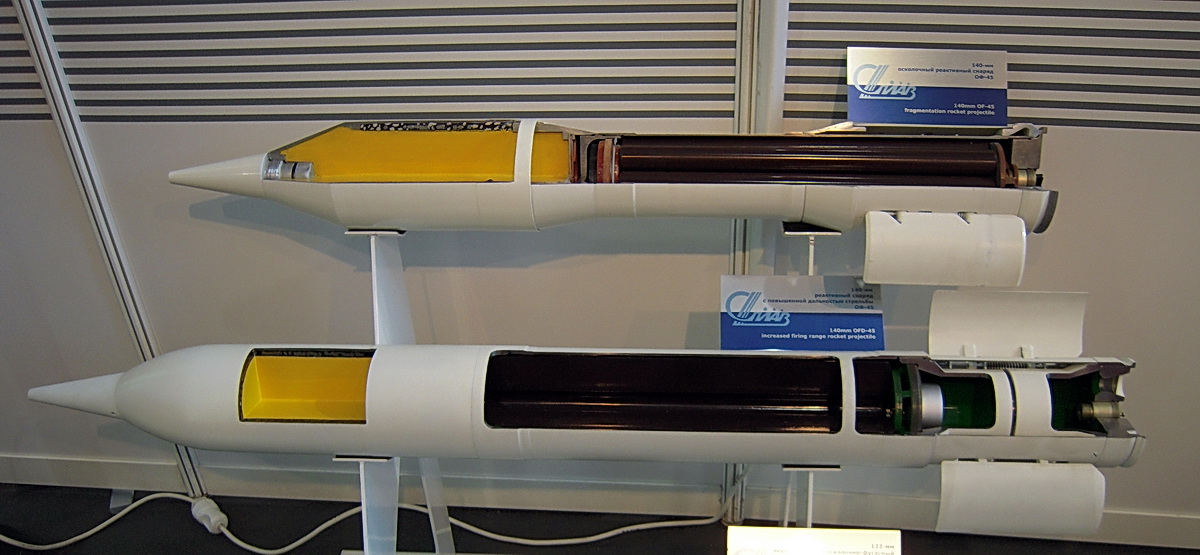
Installation of combat units on MT-LB
The cases of a whole fighting compartment installed on the armored tractor chassis deserve a separate section.
Combat vehicle with BTR-70/BRDM turret
Since the beginning of the Anti-Terrorist Operation, one of the most popular areas of “heavy” modernization of the Soviet tractor has been the welding of a new superstructure over the landing compartment of the vehicle with turrets from Soviet armored personnel carriers with a KPVT heavy machine gun.
Such a “DIY-modernization” by itself is of little interest except for the fact of its existence, but it is worth noting such an amazing design as MT-LB with welded part of the hull of the Soviet BRDM-2 reconnaissance vehicle. Interestingly, the vehicle was filmed already during the Russian invasion of Ukraine.
Artillery system with a BMP-1 turret
The separatists’ 73-mm self-propelled artillery systems based on armored tractors with a combat compartment removed from the BMP-1 have become a rather specific product of the six-year-long positional fighting in Donbas.
Years of “staying” in the same positions and a ban to use artillery with a caliber above 100mm next to the front line gave rise to a new branch of military art development. Within specific conditions, the military on both sides of the front learned to conduct “sniper” fire from medium-caliber guns and rapid position changes to evade counter-battery fire.
The main tools of such “snipers” included SPG-9 73-mm recoilless guns and BMP-1 infantry fighting vehicles with a gun of the same caliber.
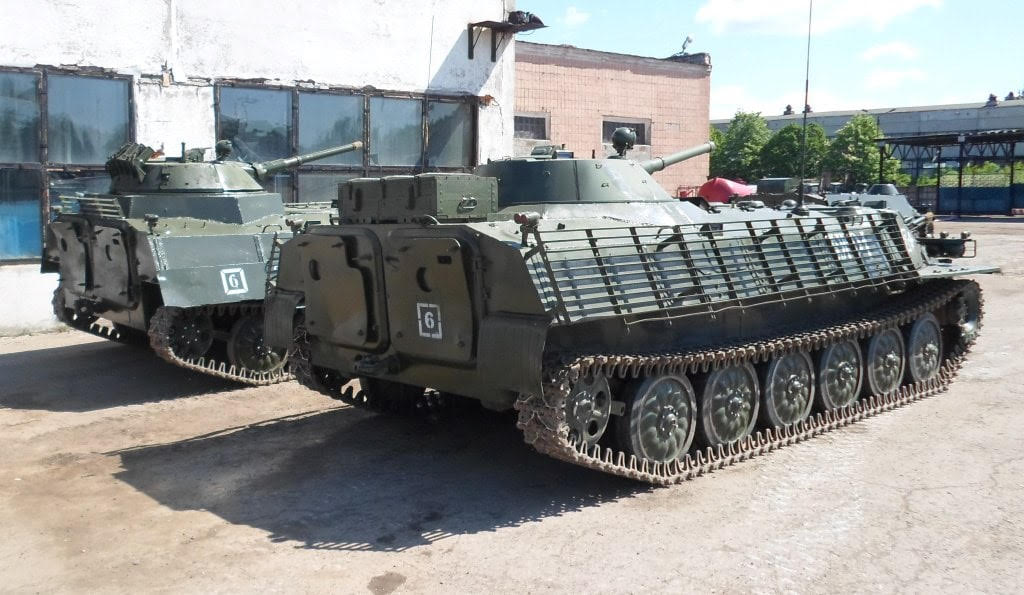
Over the years of “trench warfare,” the shooting skills have reached a level where an experienced crew could hit an enemy infantry fighting vehicle at a distance of 7,000 meters with a fragmentation munition with the first two shots, and from two kilometers away, they could lay a grenade in a 50-by-50-centimeter square.
The installation of an IFV turret on the new chassis was most likely a forced step for the separatists due to the loss of capacity of the original chassis and the strong need for at least some armored vehicles.
MT-LB 6МB
This list should also include one rare Russian serial modernization of the tracked vehicle with a 2А72 30mm automatic gun. The latter is also installed on Russian BTR-82 and BMP-1АМ.
Russian invasion forces lost at least one MT-LB 6МB tracked vehicle during the Russian-Ukrainian war.
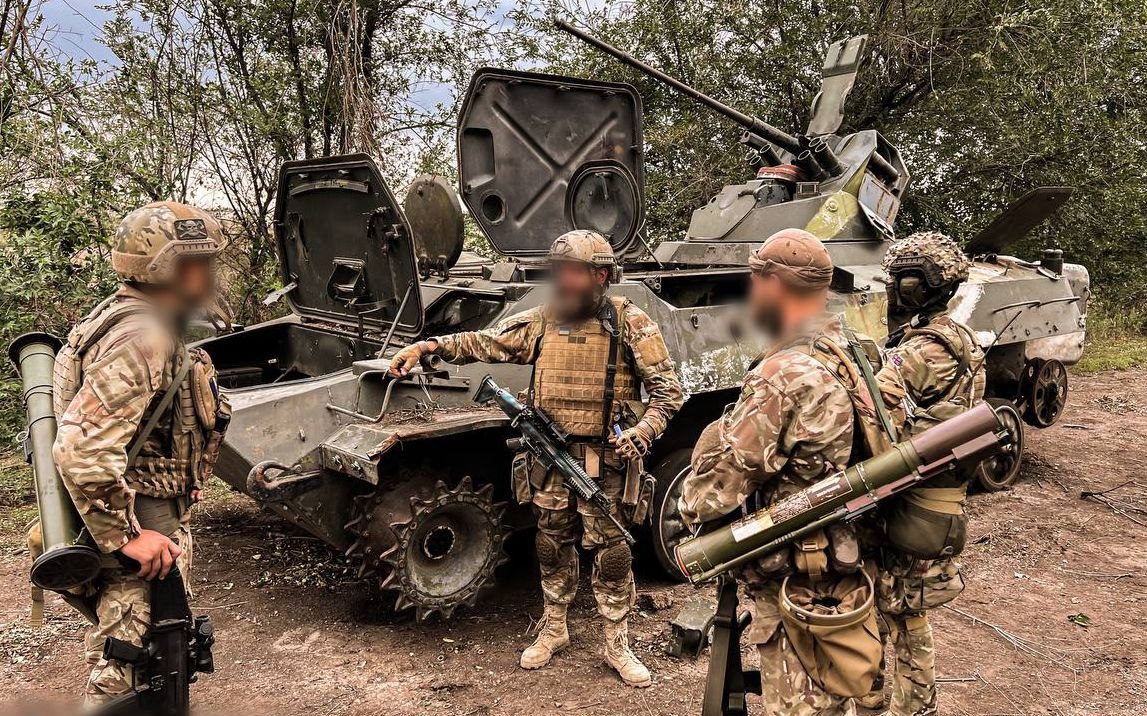
120mm self-propelled mortar on MT-LB chassis
One of the most interesting modifications is the separatists installing a combat compartment from the self-propelled mortar Nona-S on the MT-LB chassis.
The reason for this modification is the relatively unsuccessful chassis design of the original self-propelled guns, borrowed from the Soviet BTR-D amphibious armored personnel carrier. Nona-S has quite a small resource, and during the first military campaign in Donbas in 2014-15, it was “killed” by numerous marches.
DIY “welding” of the tractor’s landing compartment and the installation of the mortar combat compartment allowed saving the combat unit from decommissioning.
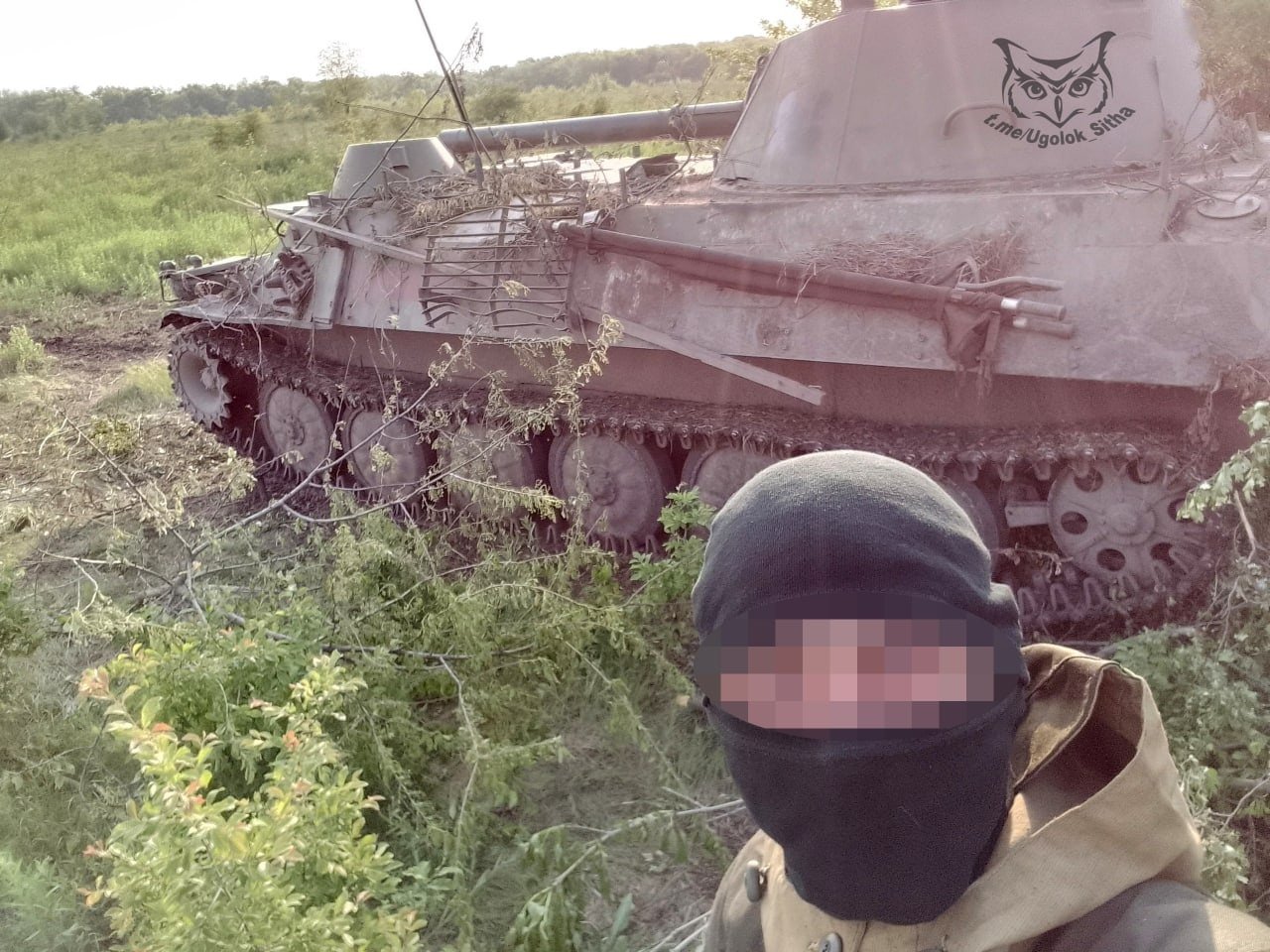
The self-propelled mortar turret is equipped with a 2А51 120mm rifled gun, capable of firing standard and specially designed for this gun rounds with direct fire and mortar-like fire. The maximum range of this artillery system is 7 kilometers with ordinary, and up to 13 km with rocket-assisted mortar rounds.
The ammunition of this artillery system also includes a specially developed 3BК19 HEAT round which can penetrate up to 600 mm homogeneous armor. The range of his direct shot is 1 kilometer.
Serdar
In the story about the integration of combat systems on the MT-LB chassis, the Ukrainian post-war improvised IFV in the form of a tracked tractor with the Turkish Serdar combat module is worth noting.
The origin of the module is unclear. They only appeared once in Ukraine during joint tests of the Turkish Aselsan and the Ukrainian Praktyka enterprise in 2021. Given the lack of mass installation of these combat modules, it can be concluded that the modules were obtained from Praktyka’s reserves.
Serdar is a remote combat module weighing about 400 kg, designed for light armored vehicles. It is designed specifically for the installation of a Soviet KPVT 14.5mm heavy machine gun. A powerful optical station with a thermal imaging channel is also on board the module.
This vehicle’s first appearance on the buoy field was publicly recorded in August 2022 in the Kharkiv region.
Conclusion
Over the years of operation and numerous wars, the MT-LB has shown its reliability and versatility, and its mass production allowed the samples to survive to this day.
In general, the culture of “DIY” construction of fire support vehicles, infantry fighting vehicles, and artillery self-propelled installations based on this tractor is not so much a merit of the chassis itself, but rather a result of the poverty of countries and their armies, which cannot afford regular production counterparts.
We can only note that this is not the last war of these vehicles, and we are awaiting many more interesting examples of “soldier’s creativity.”
SUPPORT MILITARNYI
Even a single donation or a $1 subscription will help us contnue working and developing. Fund independent military media and have access to credible information.


 Роман Приходько
Роман Приходько 
 Віктор Шолудько
Віктор Шолудько 
 Андрій Харук
Андрій Харук 

 Андрій Тарасенко
Андрій Тарасенко 
 Yann
Yann 
 СПЖ "Водограй"
СПЖ "Водограй" 

 ГО "Військова школа "Боривітер"
ГО "Військова школа "Боривітер" 

 Катерина Шимкевич
Катерина Шимкевич 
 Олександр Солонько
Олександр Солонько 
 Андрій Риженко
Андрій Риженко 